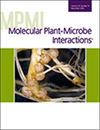Martin Darino, Namrata Jaiswal, Reynaldi Darma, Erika Kroll, Martin Urban, Youhuang Xiang, Moumita Srivastava, Hye-Seon Kim, Ariana Myers, Steven R Scofield, Roger W Innes, Kim E Hammond-Kosack, Matthew Helm
求助PDF
{"title":"The <i>Fusarium graminearum</i> Effector Protease FgTPP1 Suppresses Immune Responses and Facilitates Fusarium Head Blight Disease.","authors":"Martin Darino, Namrata Jaiswal, Reynaldi Darma, Erika Kroll, Martin Urban, Youhuang Xiang, Moumita Srivastava, Hye-Seon Kim, Ariana Myers, Steven R Scofield, Roger W Innes, Kim E Hammond-Kosack, Matthew Helm","doi":"10.1094/MPMI-08-24-0103-FI","DOIUrl":null,"url":null,"abstract":"<p><p>Most plant pathogens secrete effector proteins to circumvent host immune responses, thereby promoting pathogen virulence. One such pathogen is the fungus <i>Fusarium graminearum</i>, which causes Fusarium head blight (FHB) disease on wheat and barley. Transcriptomic analyses revealed that <i>F. graminearum</i> expresses many candidate effector proteins during early phases of the infection process, some of which are annotated as proteases. However, the contributions of these proteases to virulence remain poorly defined. Here, we characterize an <i>F. graminearum</i> endopeptidase, FgTPP1 (FGSG_11164), that is highly upregulated during wheat spikelet infection and is secreted from fungal cells. To elucidate the potential role of FgTPP1 in <i>F. graminearum</i> virulence, we generated <i>FgTPP1</i> deletion mutants (Δ<i>Fgtpp1</i>) and performed FHB infection assays. Deletion of <i>FgTPP1</i> reduced the virulence of <i>F. graminearum</i> as assessed by spikelet bleaching. Infection with wild-type <i>F. graminearum</i> induced full bleaching in about 50% of the spikes at 10 to 11 days postinfection, whereas this fraction was reduced to between 18 and 27% when using Δ<i>Fgtpp1</i> mutants. Transient expression of green fluorescent protein-tagged FgTPP1 revealed that FgTPP1 localizes, in part, to chloroplasts and attenuates chitin-mediated activation of mitogen-activated protein kinase signaling, reactive oxygen species production, and cell death induced by an autoactive disease resistance protein when expressed in planta. Notably, the FgTPP1 protein is conserved across the Ascomycota phylum, suggesting that it may be a core effector among ascomycete plant pathogens. These properties make FgTPP1 an ideal candidate for decoy substrate engineering, with the goal of engineering resistance to FHB. [Formula: see text] Copyright © 2025 The Author(s). This is an open access article distributed under the CC BY-NC-ND 4.0 International license.</p>","PeriodicalId":19009,"journal":{"name":"Molecular Plant-microbe Interactions","volume":" ","pages":"297-314"},"PeriodicalIF":3.4000,"publicationDate":"2025-03-01","publicationTypes":"Journal Article","fieldsOfStudy":null,"isOpenAccess":false,"openAccessPdf":"","citationCount":"0","resultStr":null,"platform":"Semanticscholar","paperid":null,"PeriodicalName":"Molecular Plant-microbe Interactions","FirstCategoryId":"99","ListUrlMain":"https://doi.org/10.1094/MPMI-08-24-0103-FI","RegionNum":3,"RegionCategory":"生物学","ArticlePicture":[],"TitleCN":null,"AbstractTextCN":null,"PMCID":null,"EPubDate":"2025/4/3 0:00:00","PubModel":"Epub","JCR":"Q2","JCRName":"BIOCHEMISTRY & MOLECULAR BIOLOGY","Score":null,"Total":0}
引用次数: 0
引用
批量引用
Abstract
Most plant pathogens secrete effector proteins to circumvent host immune responses, thereby promoting pathogen virulence. One such pathogen is the fungus Fusarium graminearum , which causes Fusarium head blight (FHB) disease on wheat and barley. Transcriptomic analyses revealed that F. graminearum expresses many candidate effector proteins during early phases of the infection process, some of which are annotated as proteases. However, the contributions of these proteases to virulence remain poorly defined. Here, we characterize an F. graminearum endopeptidase, FgTPP1 (FGSG_11164), that is highly upregulated during wheat spikelet infection and is secreted from fungal cells. To elucidate the potential role of FgTPP1 in F. graminearum virulence, we generated FgTPP1 deletion mutants (ΔFgtpp1 ) and performed FHB infection assays. Deletion of FgTPP1 reduced the virulence of F. graminearum as assessed by spikelet bleaching. Infection with wild-type F. graminearum induced full bleaching in about 50% of the spikes at 10 to 11 days postinfection, whereas this fraction was reduced to between 18 and 27% when using ΔFgtpp1 mutants. Transient expression of green fluorescent protein-tagged FgTPP1 revealed that FgTPP1 localizes, in part, to chloroplasts and attenuates chitin-mediated activation of mitogen-activated protein kinase signaling, reactive oxygen species production, and cell death induced by an autoactive disease resistance protein when expressed in planta. Notably, the FgTPP1 protein is conserved across the Ascomycota phylum, suggesting that it may be a core effector among ascomycete plant pathogens. These properties make FgTPP1 an ideal candidate for decoy substrate engineering, with the goal of engineering resistance to FHB. [Formula: see text] Copyright © 2025 The Author(s). This is an open access article distributed under the CC BY-NC-ND 4.0 International license.
小麦赤霉病效应蛋白酶FgTPP1抑制免疫反应并促进赤霉病的发生。
大多数植物病原体分泌效应蛋白来规避宿主免疫反应,从而提高病原体的毒力。其中一种病原体是真菌镰刀菌,它引起小麦和大麦的镰刀菌头疫病(FHB)。转录组学分析显示,F. graminearum在感染过程的早期阶段表达了许多候选效应蛋白,其中一些被注释为蛋白酶。然而,这些蛋白酶对毒力的贡献仍然不明确。在这里,我们表征了一种小麦小麦内多肽酶FgTPP1 (FGSG_11164),该酶在小麦小穗感染期间高度上调,并由真菌细胞分泌。为了阐明FgTPP1在F. graminearum毒力中的潜在作用,我们生成了FgTPP1缺失突变体(ΔFgtpp1)并进行了FHB感染测定。通过小穗白化鉴定,FgTPP1的缺失降低了禾谷镰刀菌的毒力。在感染后10-11天,野生型谷草镰刀菌侵染导致约50%的穗完全漂白,而使用ΔFgtpp1突变体时,这一比例减少到18%至27%之间。绿色荧光蛋白(GFP)标记的FgTPP1的瞬时表达表明,FgTPP1部分定位于叶绿体,并在植物中表达时减弱几丁质介导的丝裂原活化蛋白激酶(MAPK)信号的激活、活性氧的产生和由自身活性抗病蛋白诱导的细胞死亡。值得注意的是,FgTPP1蛋白在子囊菌门中是保守的,这表明它可能是子囊菌植物病原体的核心效应物。这些特性使FgTPP1成为诱饵衬底工程的理想候选者,其目标是工程抵抗FHB。
本文章由计算机程序翻译,如有差异,请以英文原文为准。

 求助内容:
求助内容: 应助结果提醒方式:
应助结果提醒方式:


